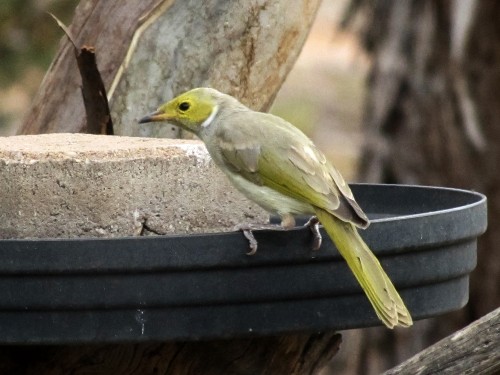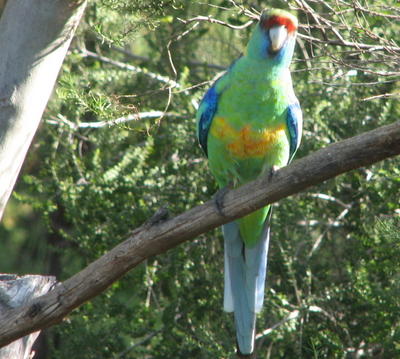Spiny-cheeked Honeyeaters
While having a relaxing breakfast a few mornings ago, several Spiny-cheeked Honeyeaters came to drink at the bird bath in our garden. Next thing a baby Spiny-cheeked Honeyeater came along begging to be fed. It was just able to fly and its tail was only half grown. Here is an example of another instance where some birds have nested in our garden and remained unobserved. They are so secretive and sneaky that this happens far too often. Never mind; it was good to see the baby getting around.
I commented to my wife that this was one species I didn’t have a photo of yet; I was wrong. I don’t have many, and the one featured above is probably the best.
Another unusual visitor to our bird bath
In recent times I have written about the behaviour of various species of birds at the bird baths we have in our garden. The birds give us many hours of entertainment as they come to drink and bathe. The very hot weather we have been having this summer helps to encourage their frequent visits.
I also wrote recently about some unusual visitors to the bird baths, a Stumpy Tail Lizard and a Red Fox.
A few days ago I was alerted to the alarm calls of a flock of New Holland Honeyeaters near the bird bath. I quietly went to have a look. The NHHEs were soon joined by several Singing Honeyeaters and a family of White Browed Babblers. All were calling madly and looking at the ground near a bush.
I waited for a few moments, fully expecting a Brown Snake (highly venomous) to emerge from the undergrowth. I had my camera at the ready and my feet ready to take off if a hasty retreat was in order.
To my great relief it was only a Blue Tongue Lizard. With the stripes on the back and tail, and a thin, long snake-like tail we have often been fooled into thinking we have a Tiger Snake (also quite venomous) in the garden. (They actually look nothing like a Tiger Snake; it’s the stripes that catch you by surprise every time.)
The new visitor didn’t wait to have a drink. A slight movement from me sent it slithering – almost snake-like – into the undergrowth again.
Related articles:
- Some unusual visitors to our birth bath – with photos.
- Time for a bath – with more photos
Updated November 2103
Time for a bath: visitors to our bird bath
Some years ago we set up a birdbath on our patio area. It gave us much pleasure to see birds coming to drink and bathe. More recently we moved it to the other side of the house. Now it is in full view from our sunroom. It is here we often eat our meals, and work at the table with the birdbath in full view.
Over recent years, this location has had four main benefits:
- It is a great time waster investment; watching the birds go about their daily lives just a few metres from where we are sitting is both relaxing and refreshing to the body, mind and spirit.
- It is most entertaining, especially when a bird like a Mallee Ringneck Parrot comes to bathe and the water sprays in all directions.
- It is excellent for photography; with the 12X zoom on my camera, I have taken many close-up shots of the birds visiting. (Update: my new camera has a 20x zoom. Further update: I now have a camera with an 83x zoom.)
- It is educational; our human visitors marvel at our avian visitors and this gives us the opportunity to further enhance our friends’ appreciation of the natural environment.
I’ve actually installed three different baths in close proximity to one another; one on the ground (which the lizards sometimes use too), one at a height of about 60cm and the third at about 1.5m. This gives them choices. The nearby branches and bushes give them a place of refuge if they feel threatened in any way.
A List of Species that have visited our bird baths:
- Mallee Ringneck Parrot
- New Holland Honeyeater
- Spiny-cheeked Honeyeater
- Red Wattlebird
- Brown-headed Honeyeater
- Singing Honeyeater
- White-plumed Honeyeater
- House Sparrow
- Common Starling
- Little Raven
- Willie Wagtail
- Spotted Turtledove
- Crested Pigeon
- Spotted Pardalote
- Striated Pardalote
- Diamond Firetail Finch
- Yellow-rumped Thornbill
- Grey Shrike-thrush
- Australian Magpie
- Magpie Lark
- Mistletoebird
- Common Blackbird
- Rufous Whistler (see updates below)
- European Goldfinch (see updates below)
- Chestnut-rumped Thornbill (see updates below)
- Grey Fantail (see updates below)
- Black-faced Cuckoo-shrike (see updates below)
- Galah (see updates below)
- Grey Currawong (see updates below)
- Eastern Rosella (see updates below)
- Sacred Kingfisher (see updates below)
- Dusky Woodswallow (see updates below)
- White-browed Babblers (see updates below)
- White-winged Chough (see updates below)
- White-browed Woodswallow (see updates below)
- Purple-crowned Lorikeet (see updates below)
- Animals
- Red Fox
- Stumpy-tailed Lizard
- European Rabbit
- Brown Snake
- Blue-tongue Lizard
That’s quite a list!
UPDATE: More recently we have added the following species to the list:
- Rufous Whistler
- European Goldfinch
- Chestnut-rumped Thornbill
UPDATE #2 Two more species to add to the list:
- Stumpy-tail Lizard (also called a Shingleback Lizard)
- Red Fox – yes, that’s right, a fox.
- Brown Snake – passed close to the bird bath on the ground. In January 2016 a metre long Brown Snake actually stopped to have a drink. See photos here.
UPDATE #3 Another species to add to the list: Grey Fantail – it came to the bird bath briefly but left before I could take a photograph (4th May, 2007)
UPDATE #4 In January 2008 we had a single Black-faced Cuckoo-shrike come to drink briefly from the bird bath.
UPDATE #5 In late January 2008 a single Galah came to within a metre of the bird bath but did not drink. A few weeks later I added Grey Currawong to the list.
UPDATE #6 In December 2008 I added European Rabbit to the list.
UPDATE #7 In December 2009 I added Eastern Rosella. (Click here for a photo)
UPDATE #8 In November 2013 a Sacred Kingfisher perched about a metre from the bird bath but did not drink. In February 2014 a Dusky Woodswallow came to drink during one of our heat waves during a very hot summer.
UPDATE #9 In September 2015 I added White-winged Chough, White-browed Babbler and Blue-tongue Lizard (click for photo)
UPDATE #10 In December 2015, during a heatwave, I added White-browed Woodswallow.
UPDATE #11 In December 2020 I added Purple-crowned Lorikeet.
Comments: many of my readers have commented on this post – read them below and leave one of your own.
Update: this post was last updated on December 2020.
Willie Wagtail accident
One of the common bird species around home here in Murray Bridge is the Willie Wagtail. This is a widespread species throughout Australia and is familiar to most people, even those with little interest in birds. We have a resident breeding pair in our garden.
From time to time one of them comes to visit our bird bath. This morning I saw the water splashing in all directions so I raced into the office to grab my digital camera. This is one species that has eluded my camera thus far.
I managed to take about eight photos before disaster struck. The Willie Wagtail upset the bird bath, knocking it and the contents to the ground. I was surprised because I had thought that even bigger birds would not be able to tip it over. It’s perched on the cut down trunk of an old dead mallee tree and has a brick inside it.
The Willie Wagtail nonchalantly flew to a nearby branch, gave his feathers a shake, preened for a few seconds and then flew off.
Perhaps I need a bigger brick.
Related articles:
Australian Ringneck
Working in the garden this afternoon I needed to stop what I was doing to take some photographs of a local species of parrot, the Australian Ringneck (also called Mallee Ringneck). I did not have to go looking for the bird in question. It was almost like it came looking for me! It flew right up to me in our plant nursery and sat on a nearby branch, not more than 3 metres away.
Of course, the camera was in the house, so I tried to casually walk into the house hoping that the ringneck would stay there. It didn’t but flew to a tree some 50 metres away. I continued working, all the time watching for the bird to return. I didn’t have to wait long. It settled in a tree near the house. I quietly went inside with the camera, planning to use our sun-room as a hide. We have three bird baths about six metres from a large picture window. We have had hundreds of very enjoyable meals watching the parade of birds coming to drink or bathe. Again, a very “good” waste of time, being very relaxing and enjoyable.
Today’s visitor was taking quite a deal of interest in the water. After taking some good photos through the window I decided to go outside and see how close I could get to the ringneck. I was able to get to about 3 metres away while the bird came down to the bird-bath and proceed to have a very thorough bath. I managed to get several more excellent photos. I then pressed the video button on the camera and filmed the bird washing and preening for about two minutes. I haven’t yet worked out whether I can make this video available on this blog.
Usually we have only two Australian Ringnecks around in the garden. In recent months there have been four, two of them juveniles. They aren’t in our garden constantly but rather roam over a wide range of the local environment. We usually love seeing them near to the house like today. When they decide to raid the orchard and nip the buds off the pear and apple trees we get just a tad annoyed – no – angry. We also get no fruit! Today I observed only one bird; I wonder if the other is nesting somewhere?











